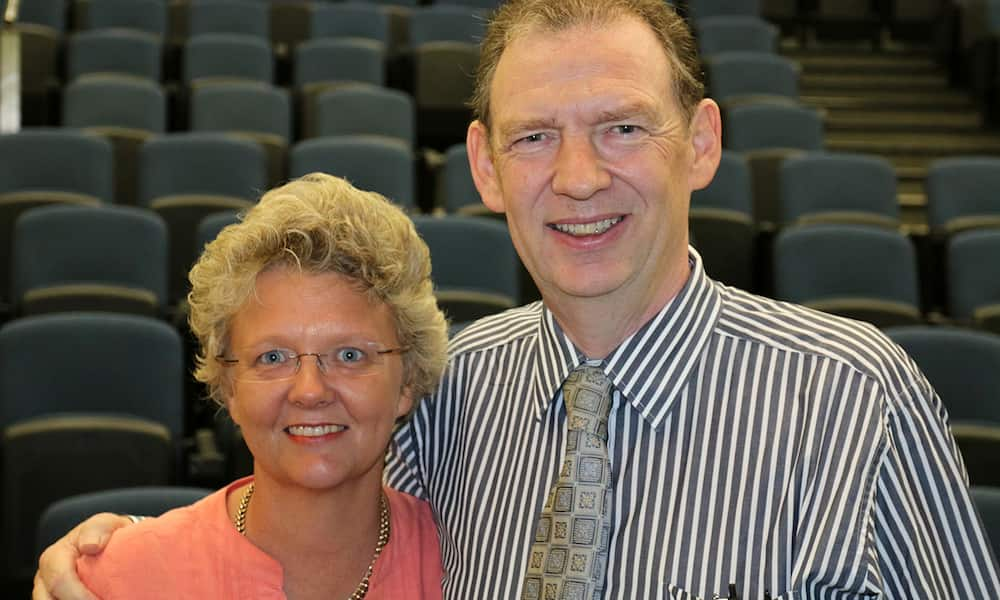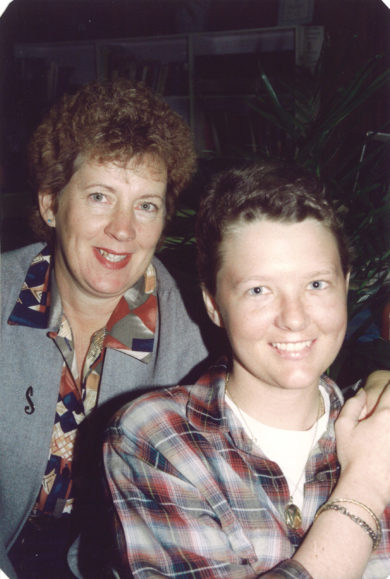“My thoughts were of total disbelief”
Judi Haidley was diagnosed with a blood cancer called leukaemia. The following are Judi’s words, shared with the Leukaemia Foundation to help raise awareness of blood cancer for September’s World CML Day and Blood Cancer Awareness Month in 2019.
Many people are affected by cancer in someway whether it is yourself, a family member or friend, and every story is different.
My story began at 20 years of age. I was enjoying the simple pleasures in life: employed at the Warwick Daily News, playing sport, good friends and a great family.
Over a few months I had been feeling tired and would come home for lunch and lay on the lounge, exhausted. Mum said I looked very pale, suggesting I could be anaemic and should have a blood test.
I placed it down to playing a lot of sport and not enough sleep. Eventually though I had to go to the doctor for I had terrible stomach cramps.
The doctor was thinking I may have endometritis [inflammation of the uterus lining], so I was given a blood test form and advised to go and have the tests after Christmas. It was December 23, 1991, and I thought I may as well go and have the tests, not thinking anything could be wrong. How wrong I was.
The next morning, I went off to work and not long after Mum rang and told one of the office girls to tell me to wait out the front because she was coming into pick me up to take me to the doctor. I still didn’t think anything could be wrong with me. I thought something had happened to my dad or brother.
Arriving at the surgery the doctor called Mum and I into the room immediately, sat us down and said: “There is no easy way to tell you, Judi. I have received your blood test results back and you have a serious illness, leukaemia.”
There was silence. My thoughts were of total disbelief. I knew it was serious but what did this mean, what was going to happen, why did I have it, how did I get it? All these questions swamped me. We gathered as a family and went straight to Brisbane for treatment. I was to spend Christmas in hospital.
What they had found was my white blood cells had failed to mature properly and as a result had multiplied to 250,000, which had overpowered the normal cells in the bloodstream. Normal range is between 4,000 and 11,000.
Diagnosis was chronic myeloid leukaemia (CML)
During the following months there were weekly blood tests, fortnightly visits to Brisbane and changes in medication to slow the progress down and make it easier to resort back to normal way of life.
I changed my doctor in Brisbane and went under the guidance of Dr Simon Durrant at the Royal Brisbane Hospital (RBH). He informed me that a bone marrow transplant (BMT) was the best form of treatment for my illness [chronic myeloid leukaemia, or CML] and eventually blood tests were being taken to check my family for compatibility of the same bone marrow.
Mum from day one asked questions, researched and sent money to the Red Cross to search overseas to find me a donor.
I was to celebrate my 21st birthday in September 1992. My brother and his wife had organised a party, but it had to be postponed three times. I was admitted to hospital with the concern my leukaemia had progressed.
Thankfully it was glandular fever.
July 22, 1993, the doctor decided who my donor was. My second cousin, Sandra Veitch, who was already on the bone marrow registrar, had been chosen. Sandra was not fully compatible but was the closest match. The only person in the whole world that could save my life was Sandra. She never even hesitated and every time I see her I say thank you!
Accommodation near hospital
The date was set for the transplant but I asked if I could wait until the day after my birthday, which I also share with Mum.
Arriving in Brisbane on September 21, 1993, Mum and Dad drove me to the Holy Spirit Hospital for the insertion of a Hickman, a central venous catheter inserted into my chest so that the veins are not used all the time.
At this stage there was no accommodation for Mum to stay at the Leukaemia Foundation units, so we booked into the Gregory Terrace Motel.
It was a concern for me because I knew it was going to be months that we were going to be in Brisbane and Mum was going to be with me the whole time.
When the Leukaemia Foundation rang and said there was a one-bedroom unit available at Herston Village, it was wonderful news.
The units are so close to the RBH, and Mum had people around her that were in the same position and understood what she was going through and I knew she was safe.
Bone marrow transplant
The BMT began. I had been admitted into Royal Brisbane Hospital and placed in an isolation room for five weeks and the only visitors allowed in the room were Mum, Dad, Cameron, Lyndal and Peter. My nephew, Heath, was two-and-a-half years old and he had to talk to me through the glass door in case of infection.
I had chemotherapy and full body radiation. During the following weeks I had everything from the first day with a burst blood vessel in my eye to all the side effects including vomiting, diarrhoea, fluid on the lungs, jaundice, mouth ulcers, hair loss and suffering a chest infection.
I had no sense smell or taste and didn’t feel like eating until Mum made me some spaghetti. From then on Mum made my dinner each night. Nothing better than home cooked meals. I’m not saying they weren’t good meals in hospital, it made one of my nurses happy as he got a meal every night!
Through all this, Sandra had taken time off from her work to have the bone marrow extracted from her hip and breast bones, which was quite painful, but she also came down many times to give me platelets which I believe was a huge boost in my recovery.
Graft vs host disease
Eventually, I was admitted into the outer wards and remember Warren, one of the exceptional nurses who looked after me, said: “Don’t get to excited, Judi, you will be back three or four times before you go home’. And he was right!
After weeks in hospital, I was allowed back to the Leukaemia Foundation unit. There were daily visits to the hospital and having a unit so close made it so much easier.
I developed a rash all over my body called graft vs host disease where my body was fighting the new bone marrow. It was terribly itchy which reduced me to tears at times.
One afternoon I started to feel unwell back in the units but did not want to go back up to the hospital. I lay quietly on the sofa bed at the unit thinking Mum wouldn’t notice.
She knew I had to be taken back and, with the assistance from Leukaemia Foundation staff, they had me in a wheelchair and back up at the hospital within 15 minutes.
Coping with cancer
The Leukaemia Foundation offers so much support through accommodation, transport and financial assistance.
The accommodation we received was enough and I was not expecting anything else as there were many families struggling like a young mum having to stay on her own in Brisbane while looking after her sick child. Home was in Roma, and her husband had to work to pay the bills and look after the other children.
We became close friends with a family from Rockhampton. Ian was two weeks ahead of me with his transplant and staying at the unit with his Mum who would stay with him while his wife worked to pay the bills.
We called Herston home for five months. I was anxious the day we left. Leaving a place that had become your security and now I was going to be two hours away in case of any emergency.
The following year I stayed at the ESA Village located near the Mater Hospital, again another wonderful place.
Over the years I have had to stay in hospital including another Christmas in 1994. I still have my yearly check-up, it gives me a peace of mind that all is ok.
There are no wise words to tell a person how to cope with cancer. A positive attitude, a will to live, a supportive family, trust in the doctors and nursing staff, the support from the Leukaemia Foundation.
Today, I take one day at a time and look forward to the days ahead. I still have regular checkups, I still get concerned with my health if something isn’t quite right, and I know my limitations.
The Leukaemia Foundation offers so much support to patients and their families during time of great illness and the great uncertainty.
Last updated on March 18th, 2021
Developed by the Leukaemia Foundation in consultation with people living with a blood cancer, Leukaemia Foundation support staff, haematology nursing staff and/or Australian clinical haematologists. This content is provided for information purposes only and we urge you to always seek advice from a registered health care professional for diagnosis, treatment and answers to your medical questions, including the suitability of a particular therapy, service, product or treatment in your circumstances. The Leukaemia Foundation shall not bear any liability for any person relying on the materials contained on this website.
